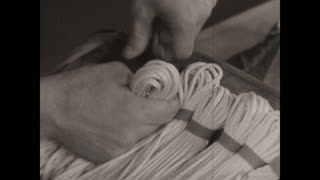This 1942 official War Department 1-536 training film produced by the U.S. Army Signal Corps in collaboration with the Chief of Air Corps shows examples of the different types of parachutes used in World War II and their materials and function. The black-and-white film opens with a group of young U.S. Army men in uniform wearing parachute packs on their backs standing in front of a World War II-era plane, possibly a P-47 Thunderbolt (0:55), and parachuting out of planes (1:01). A machine factory blade precisely cuts a silk or nylon parachute (1:10). Planes conduct parachute drop tests (1:30). Riggers pack and maintain parachutes (1:47). A closeup shows the main parachute parts: canopy and suspension line (2:04), pack assembly (2:10), harness (2:13), and pilot parachute (2:20). A diagram of a parachute, as the narration explains each part in more detail (2:33). Connector links attach the harness to the suspension lines (2:37). A rigger opens and closes the puckered vent (3:33) at the apex, which opens to relieve strain on the canopy during descent. The rigger demonstrates how the pilot parachute attaches to the apex (3:56). Footage of a pilot parachute opening midair and dragging the main canopy into position (4:13). The pack, shown at 4:18, is the container in which the canopy and suspension lines are packed. Army soldiers wearing different size parachute packs (4:28): a small seat parachute (4:33) holds up to 180 lbs and descends faster, while a large seat parachute (4:40) holds more weight. A form-fitting back parachute (4:47) allows more movement, attachable parachutes (5:00) are used in small spaces, and a training double parachute (5:08) has two independent packs on one person. A closeup of the locking device used on all parachutes except training ones: solid drawn wire prongs on the end of a rip cord (5:34). Elastics attached to the cord help open the parachute faster. An airman demonstrates grabbing and jerking the rip cord handle (6:07). A closeup of the rip cord (6:13), made of a flexible steel cable and locking pins wrapped in wire and soldered to the cable. At 6:40, the service-type parachute is explained and demonstrated: the pack is reinforced with wire and suspension lines are secured by rubber loops (6:50) attached to a tape. The soldier wraps a loop around a bundle of suspension lines (7:03), and then puts the canopy on top. He packs the pilot parachute into a separate compartment (7:28). A closeup of the harness (7:35), which attaches the parachute to the wearer. An airman wears the two main risers of the harness (7:47), which attach to the suspension lines with connector links and form the seat swing and leg straps (8:03). One Army soldier checks the back straps of another soldier (8:10). The harness locks in front with a breast strap. Closeups of the adapters at the shoulders and legs (8:49). A triple adapter (9:08) is on some older harnesses. Fasteners at each leg strap (9:18) secure the harness at the bottom; the closure can be a snap and V-ring (9:20) or bayonet-type. The soldier stuffs the pack into his kit bag (9:42). The film ends by emphasizing the importance of properly packing and inspecting parachutes to ensure flyer safety.
Motion picture films don’t last forever; many have already been lost or destroyed. For almost two decades, we’ve worked to collect, scan and preserve the world as it was captured on 35mm, 16mm and 8mm movies — including home movies, industrial films, and other non-fiction. If you have endangered films you’d like to have scanned, or wish to donate celluloid to Periscope Film so that we can share them with the world, we’d love to hear from you. Contact us via the weblink below.
This film is part of the Periscope Film LLC archive, one of the largest historic military, transportation, and aviation stock footage collections in the USA. Entirely film backed, this material is available for licensing in 24p HD, 2k and 4k. For more information visit http://www.PeriscopeFilm.com


